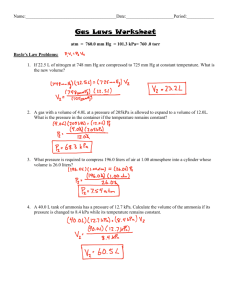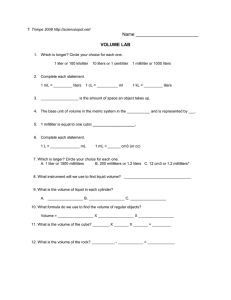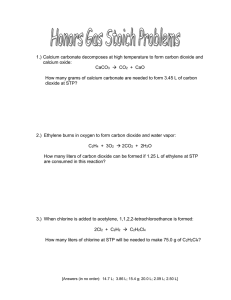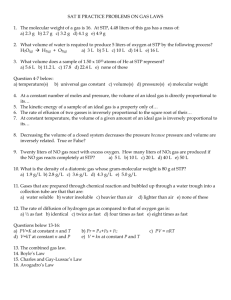The Gaseous State
advertisement
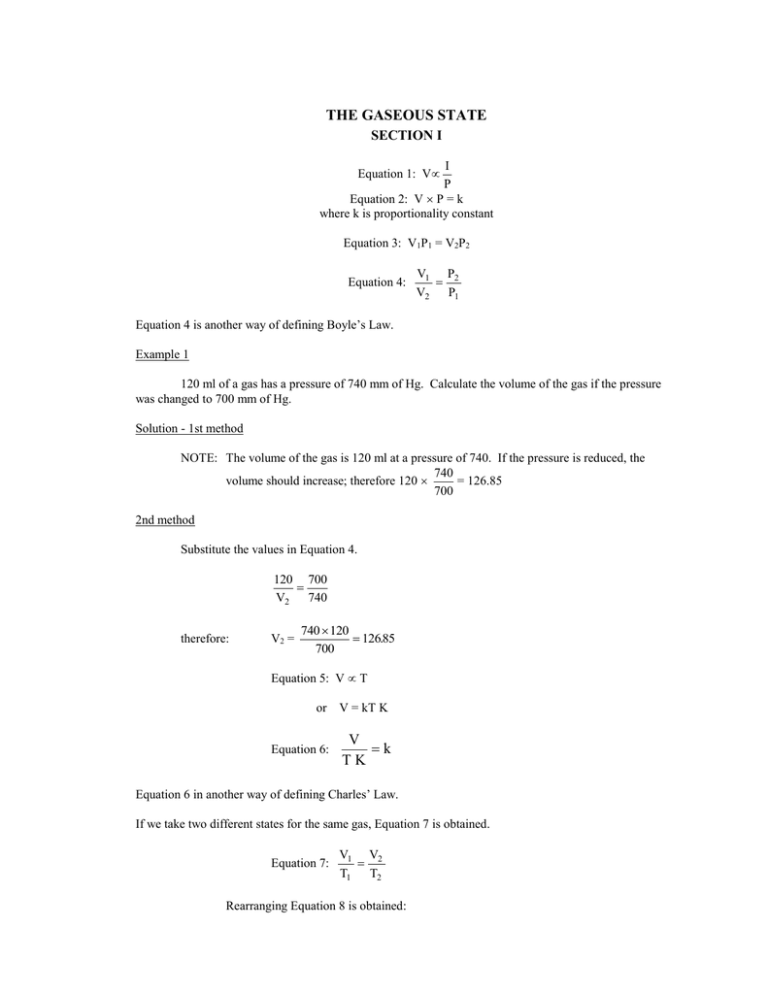
THE GASEOUS STATE SECTION I I P Equation 2: V P = k where k is proportionality constant Equation 1: V Equation 3: V1P1 = V2P2 Equation 4: V1 P2 V2 P1 Equation 4 is another way of defining Boyle’s Law. Example 1 120 ml of a gas has a pressure of 740 mm of Hg. Calculate the volume of the gas if the pressure was changed to 700 mm of Hg. Solution - 1st method NOTE: The volume of the gas is 120 ml at a pressure of 740. If the pressure is reduced, the 740 volume should increase; therefore 120 = 126.85 700 2nd method Substitute the values in Equation 4. 120 700 V2 740 therefore: V2 = 740 120 126.85 700 Equation 5: V T or V = kT K Equation 6: V k TK Equation 6 in another way of defining Charles’ Law. If we take two different states for the same gas, Equation 7 is obtained. Equation 7: V1 V2 T1 T2 Rearranging Equation 8 is obtained: Equation 8: V1 T1 V2 T2 Example 2 100 ml of gas has a temperature of 20C. Calculate the gas at 100C. Solution - 1st method Change the temperature from centigrade to the Kelvin scale. C + 273 = K Note that the gas of a volume of 100 ml at 20. T1 = 20C + 273 = 293 K T2 = 100C + 273 = 373 K 100 373 = 127.3 ml 293 2nd method Substitute values in Equation 8 and solve for V2. 100 293 V2 373 V2 = 100 373 = 127.3 293 The mathematical expression for combination of Charles’ Law and Boyle’s is given by Equation 9. Equation 9: P1 V1 P2 V2 T1 T2 Example 3 A sample of a gas occupied 200 ml at 20C and 740 mm of Hg. Calculate the volume of the gas at 0C and 760 mm of Hg. Solution - 1st method Change the temperature from C to K. T1 = 20C + 273 = 293 K T2 = 0C + 273 = 273 K Apply Charles’ Law, then Boyle’s Law The gas occupies 200 ml at 293, the temperature dropped; therefore, the volume decreased. The pressure was increased--hence, the volume decreased. 200 = 273 740 = 181.4 ml 293 760 2nd method Substitute the values given in Equation 9 and solve for V2. (740)(200 ( V2 )(760) 293 273 V2 = 740 200 273 = 181.4 293 760 NOTE: The first method of solving examples 1, 2, and 3 has an advantage over method 2 because in the 1st method we are using the application of Charles’ Law and Boyle’s Law without memorizing the equations. SECTION II 1. The volume of a gas is 800 l at 750 mm of Hg and 30C. What volume will the gas occupy at 710 mm of Hg and 30C? 2. A gas has a volume of 500 ml at 700 mm of Hg. What will its volume be at 800 mm of Hg if the temperature is constant? 3. A gas occupies 200 ml at 0C. Calculate its volume at 100C. Pressure is kept constant. 4. 200 liters of He measured at 12C and 750 mm. Calculate the volume of the gas at 720 mm of Hg at 40C. 5. 1 liter of H2 was measured at STP. Calculate the volume at 300C and 25 at. ANSWERS FOR SECTION II 1. 2. 3. 4. 5. 845.1 liter 437.5 ml 273.26 ml 228.8 liter .0839 liter or 83.9 m l SECTION III Based on Avogadro’s Law, 1 mole (1 molecular weight) of any gas at STP occupies 22.4 liters and contains 6.02 1023 molecules. 22.4 liters at STP is known as molar gas volume. Example 4 It was found that 2.8 liters of unknown gas measured at STP weighed 4 g. Calculate the molar weight of the gas. Solution Since the volume of the gas was measured at STP, then we need to find the weight of 22.4 liters of the gas which represents one molecular weight. 2.8 liters 4 x (?) 22.4 x= 22.4 4 = 32 g 2.8 Example 5 1.3 liters of a gas measured at a temperature of 25C and a pressure of 800 mm of Hg was found to weigh 2.3 g. Calculate the molar weight of the gas. Solution Since the volume (1.3) was not measured at STP, then the first step will be to change the volume of the gas to STP. 13 . 273 800 125 . liters 298 760 Then find the weight of 22.4 liters at STP. 1.24 liters = 2.3 g 22.4 liters = x (?) x= 22.4 2.3 = 41.5 g 124 . Example 6 Calculate the volume of oxygen at 20C and 740 mm liberated from decomposing 10 g of KClO 3 according to KClO3 KCl + O2. Solution - 1st method The first step is to balance the reaction 2KClO3 2KCl + 3O2 2 moles of KClO3 122.6g = 245.2 g mole 3 moles of oxygen occupy 3 22.4 liters at STP 2KClO3 2KCl + 3O2 245.2 g 67.2 liters at STP 10 ? 10 67.2 = 2.74 liters 245.2 Now we need to change the volume of oxygen from STP to the conditions given in the problem. 2.74 liters at 273 K and at 760 mm ? 293 K 740 mm 2.74 293 760 = 3.02 273 740 2nd method 2KClO3 2KCl + 3O2 245.2 96 10 ? 10 96 = 3.92 g of oxygen 245.2 1 mole of any gas at STP occupies 22.4 liters 1 mole of oxygen weighs 32 g. That is 32 g 22.4 liters 3.91 g ? 3.91 22.4 = 2.74 liters at STP 32 This volume (2.74 at STP) is changed to 20C and 740 mm of Hg. SECTION IV 1. What volume will 2.7 moles of He occupy at STP: 2. 2 liters of a gas at STP weigh 5.7 g. Calculate the molecular weight of the gas. 3. 2.38 liters of a gas at 97C and 720 mm of Hg weigh 2.18 g. Calculate the molecular weight of the gas. 4. 1.36 liters of a gas at 22C and 740 mm of Hg weigh 2.6 g. Calculate the molecular weight. ANSWERS FOR SECTION IV 1. 2. 3. 4. 60.48 liter 63.84 g 29.4 g 47.54 g SECTION V Dalton’s Law PT PO2 PCl2 PCO2 where PT = total pressure PO2 = partial pressure of oxygen PCl 2 = partial pressure of chlorine PCO2 = partial pressure of carbon dioxide That is PT = PH2O PO2 If we assume that the temperature at which O2 was collected is 20C, and the barometric pressure reading is 755.4 mm, then from the table of vapor pressure of water at different temperatures, 20C the vapor pressure of water is 17.5 mm. Therefore PO2 = 755.4 - 17.5 = 737.9 mm. Example 7 Calculate the weight of dry oxygen in 800 ml of moist oxygen collected over water at 22C and 744.6 mm of Hg. Solution The total pressure 744.6 is due to the partial pressures of O 2 and to the water vapor pressure. The partial pressure of H2O at 22C obtained from the tables is 19.8 mm. Therefore, the partial pressure of dry O2 is: PT - PH 2O PO2 744.6 - 19.8 = 724.8 mm Now we need to change the volume of oxygen from 22C and 724.8 mm to STP. 800 l at 295K and 724.8 mm ? 800 273K 760 mm 273 724.8 = 706.05 ml 295 760 We know that 1 mole of any gas occupies 22.4 liters at STP. For oxygen: 32 g 22.4 liters ? 706 liters .706 32 = 1.0 g 22.4 SECTION VI 1. 600 ml of a gas collected at 25C and 740 mm. What will the dry volume of the gas be at 20 and 750 mm? 2. 200 ml of H2 at 1200 mm are added to a 400 ml cylinder and 400 ml of C2H6 under a pressure of 800 mm were added to the same cylinder. What is the total pressure in the cylinder? ANSWERS FOR SECTION VI 1. 2. 563.38 ml 1400 mm Hg DIFFUSION SECTION VII Equation 10: R1 R2 d2 d1 Equation 11: R1 R2 MW2 MW1 Example 8 What is the ratio of the rate of diffusion of N2 to that of H2? Solution Substitute the values given in Equation 11. R N2 R H2 R N2 R H2 MW H 2 MW N 2 2 28 R N 2 141 . R H 2 5.29 That is hydrogen diffusing 3.75 times as fast as nitrogen. Example 9 CH4 diffuses at 5 ml/sec. while unknown gas diffuses at the rate of 10 ml/sec. Calculate the MW of the unknown gas. Solution Substitute the values given in Equation 11. 5 x 10 16 5 x 10 4 then 2 = 4=x x IDEAL GAS LAW SECTION VIII Equation 12: V nT P Equation 13: PV = nRT n= g MW Equation 14: PV = g RT MW Example 10 Calculate the pressure of 20 g of H2 in a 2 liter cylinder at 20C given R = .082 1 at K mole Solution Substitute the values in Equation 13. (P) (2) = 20 .082 293 120 2 SECTION IX 1. HBr diffuses at the rate of 15 ml/min. What will be the rate of diffusion of CH 4? 2. CH4 diffuses at the rate of 12 ml/sec. Calculate the molecular weight of a gas that diffuses at the rate of 8 ml.sec. 3. 14.2 moles of He were contained in a 25 liter cylinder at 40C. Calculate the pressure of the gas. 4. How many molecules of H2S are present in 22.4 liters measured at 0C and 304 cm of Hg? ANSWERS FOR SECTION IX 1. 2. 3. 4. 33.75 ml 36 g 14.58 at. 2.408 1024 molecules
